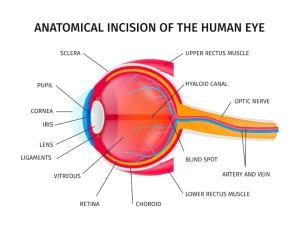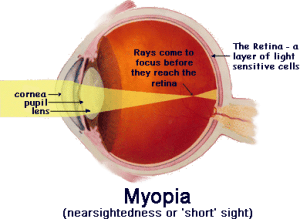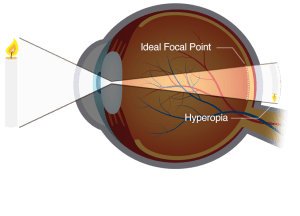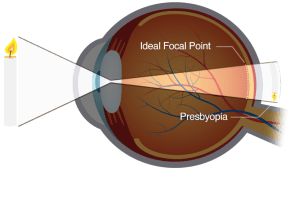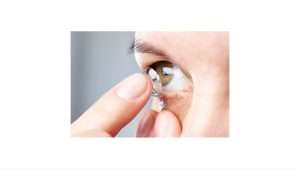“We are only as blind as we want to be.”
This quote by Maya Angelou holds true on so many levels. Philosophically, this blindness can arise from ignorance, ego, denial, etc. and some introspection is required to treat it, whereas practically, a person whose eyes cannot focus the outside images clearly and has poor eyesight can seek help from an eye doctor to see better.
According to WHO, along with cataracts, the leading cause of vision impairment and blindness is uncorrected refractive errors.
How does an eye see?
Normally, the light reflected by objects enters the clear cornea (the outer transparent layer of the eye) onto the lens, which then bends it to focus it on the retina (the inner layer of the eye that senses light).
This visual information is then sent to the brain via the optic nerve (structure connecting the eye to the brain). The brain then processes and interprets this information to form the image.
What causes refractive error
Refractive error is mainly influenced by genetics and passed on to children from their parents. Research has shown that environmental factors like increased near work (reading, writing, etc) can cause short or nearsightedness along with genetic predilection.
The factors that influence refraction in the eyes that don’t allow the light to focus on the retina properly are:
1. Size of the eyes (long or small)
2. The shape of the structure of the eye like cornea or lens (irregular/asymmetric/flat/steep)
3. Ageing of lens
The changes in size, shape, and aging lens cause different types of refractive error.
Symptoms of refractive error
- Blurred vision
- Difficulty reading or seeing up close
- Headache
- Squeezing eyes to see clearly
- Crossing/squinting of the eyes in children (esotropia)
What are the types of refractive error?
There are 4 main types of refractive error:
1. Myopia (nearsightedness)
2. Hyperopia (farsightedness)
3. Astigmatism and
4. Presbyopia (loss of near vision with age)
Myopia
Myopia is usually seen in eyes that are too long or have strong focusing power. Therefore the image is formed in front of the retina. Patients see close objects clearly but distant objects are blurry, hence it’s called short/nearsightedness. Keeping an eye on myopia progression is crucial as people with high myopia are predisposed to severe eye problems such as retinal detachment and cataracts.
Hyperopia
It is usually seen in eyes that are too short or are weak and have low focusing power. Therefore the image formed is behind the retina. Close objects are more blurry than distant objects, hence it’s called farsightedness.
Presbyopia (Ageing of the lens in the eye)
On reaching 40, the lens starts losing its ability to focus on near objects, making near activities difficult such as reading, threading a needle, etc. Therefore they need additional aid for near work on top of existing distance spectacle correction.
Astigmatism
The outer surface of our eyes called the cornea is spherical or curved equally in all directions. Astigmatism usually occurs when the cornea is irregular or has an asymmetric curvature that is more curved in one axis than the other.
The light that hits an eye with astigmatism is distorted and refracted to multiple focus points within the eye instead of on one focus point on the retina, causing blurred vision at all distances, close up, and far away and affecting the crispness of the image.
Tests and Diagnosis
A refractive error is diagnosed by asking the patient to read a distant vision chart and near vision chart. Vision is then tested with different lenses to come to the best-corrected visual acuity, which is then prescribed for glasses.
How are refractive errors treated?
The refractive error can be corrected by any of the following options. It mainly depends on what type of refractive error the individuals have and their preferences and lifestyle. The options include
- Eyeglasses
- Contact lenses
- Refractive surgery
Eyeglasses
Glasses and contact lenses aim to add another optical surface that reduces the power of the eyes (for myopes) by having a minus number or increases the focusing power by having a + number (used in hyperopes) so that the objects can be focused on the retina and can be seen clearly. For astigmatism, power can be added on a particular axis to make the image sharp. To know about the pros and cons of glasses and contact lenses, click here.
Types of Eyeglasses
Eyeglasses are not a “one size fits all” type of solution. Each person will require a different type of eyeglass, depending on their refractive error.
For myopia or hypermetropia, single vision glasses are prescribed.
Presbyopia, in the absence of any other refractive error, can sometimes be treated with over-the-counter reading glasses
Presbyopic patients with other refractive errors can opt for multifocal prescription lenses which correct both near and distance vision. These are
Bifocals
These types of lenses have two powers. They provide near vision correction in the bottom half and distance vision correction in the top half. These types have a line in between the two powers that can be seen from the outside.
Progressive lenses
They are multifocal lenses that are designed in such a way that in addition to correcting near and distance, it also corrects intermediate vision, which is the vision required for doing activities at an arm’s length, such as computer work.
Unlike bifocals, where there is image jump due to the line between the near and distance power, the incorporation of these powers in progressive lenses is so seamless that it cannot be made out. These may be difficult to get used to at first, but ophthalmologists and opticians help out by giving useful tips so that the patients can get adjusted to them soon.
Contact Lenses
Contact lenses function similarly to eyeglasses, making them a perfect alternative for many people. The advantages of contact lenses over spectacles are
1. Natural field of view
2. Better cosmesis
3. No problems of fogging as there are with spectacles
4. Clarity is better as the image is focused better with contact lenses.
Types of Contact Lenses
Hard contact lenses
The most common type of hard contact lens is a rigid gas-permeable (RGP) lens. These are made of a silicon-containing compound that allows oxygen to pass through, which nourishes the cornea.
They are prescribed to patients with high cylindrical power or astigmatism, in whom soft contact lenses don’t provide desired vision, or patients with keratoconus, where the cornea is shaped irregularly.
These lenses are firm and they retain their shape even after blinking, providing a smooth surface over irregular cornea so that the patient can focus better, resulting in sharper and clearer vision.
Soft contact lenses:
Unlike hard contact lenses, soft contact lenses are made of flexible plastic which makes them more comfortable and easy to wear.
1. Daily wear contacts
These are preferred for hygiene purposes as they are replaced after every use therefore chances of infection and allergies are less. These need to be taken out before sleep.
2. Extended wear contacts
You can choose these contacts as they last longer and only need to be replaced once a week, every two weeks, or every month while some can also be left in while sleeping.
But most ophthalmologists advise against it and recommend disposable daily wear.
This is because they require daily cleaning and if not cleaned properly, it can lead to serious eye infections.
Although the cost is less as compared to daily wear, the cost of cleaning or disinfecting solutions adds up and you end up spending almost the same as most of the daily wear contact lenses.
3. Toric contacts
These can correct vision for people with cylindrical power or astigmatism. Toric lenses also come in daily or extended wear but they often cost more than other types of soft contact lenses.
REFRACTIVE SURGERY
The dependency on spectacles and contact lenses can be reduced by opting for refractive surgery. The various options are
1. PRK
2. LASIK
3. Contoura Vision LASIK or customized wavefront-guided LASIK
4. ReLEx SMILE
5. Phakic IOL
6. Refractive lens exchange
To know more about refractive surgery, you can read this article.
QUICK SUMMARY
Uncorrected refractive error is the most common cause of visual impairment worldwide therefore it is important to get your sight tested regularly, especially in preschool children. If not diagnosed on time, uncorrected refractive error in children may lead to lazy eye or amblyopia. An annual eye examination is therefore very important in all individuals.
If you have any doubts or queries regarding this topic, please feel free to drop us a message.
Disclaimer: The content on this site is for general information only and should not be used as a substitute for professional medical advice.

